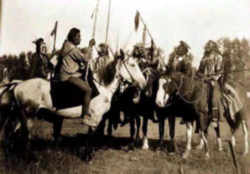


Iowa Early History
First Early Inhabitants of Iowa

Early history examines the archaeological record that tells the story of the first inhabitants of Iowa. Learn about the prehistory and culture of the first early inhabitants, and what lessons it might teach us about the early history of Iowa.
Iowa First Early Inhabitants Timeline
- 74Mil BC - In the Manson Impact a meteorite hit what is now Manson Iowa at an estimated 60,000 mph and formed a crater 24 miles wide with an impact 3 1/2 miles deep. (SFEC, 7/5/98, p.A10)
- 9500 - 7500 BC - Paleo-Indians probably traveled through Iowa hunting various animals including some - like the mammoth, mastodon and giant bison - that are now extinct.
- 7500 - 5500 BC Archaic Period - Evidence that small numbers of people lived in Iowa, at least on a seasonal basis
- 2500 - 500 BC - Populations increased and there is evidence of burial sites and more permanent settlements.
- 1000 AD - Woodland period - native people were adjusting to the prairies
- 1000 - 1650 Late Prehistoric time - native people were adjusting to the prairies, planting corn, building earthlodge houses and hunting bison for meat and hides.
- 1682 - Rene-Robert Cavelier de La Salle (1643-1687) explored the region for France
- 1712 - The First French Fox War (1712–1716)
- 1728 - The Second Fox War (1728–1733), the Fox were reduced to 500 by French troops and Indian allies. The Fox tribe join the Sauk Tribe after defeat
- 1764 - Pontiac's Rebellion broke out in the Ohio River Valley. The Ottawa Chief Pontiac (1720-1769) to lead a rebellion of a number of tribes against the British
Early History of Native Americans in Iowa
The Indigenous People of Iowa
Some tribes adopted the woodland culture and others the Great Plains culture. The woodland tribes were the Illinois, Iowa, Nez Perce, Pahodja, Pawnee, Winnebago, Missouria, Moingwena, Omaha, Otoe, Ottawa, Peoria, Ponca, Potawatomi and the Winnebago (also known as the Ho-Chunk Nation). Other tribes included the Chippewa, Dakota Sioux, Fox and Sauk. By the 1850s, almost all of the original inhabitants of Iowa had been moved off their homelands to settlements further west.
Paleo-Indians living between 9500 and 7500 BC probably traveled through Iowa hunting various animals including some - like the mammoth, mastodon
and giant bison - that are now extinct. However, there is no documented site of a permanent settlement of these people in the area we now call Iowa.
By the early Archaic Period (7500 - 5500 BC), however, there is evidence that small numbers of people lived in Iowa, at least on a seasonal basis.
There is evidence of artifacts like spear points and serrated and beveled blade edges. Populations increased through the late Archaic Period (2500
- 500 BC) and there is evidence of burial sites and more permanent settlements.
In the Woodland period (through 1000 AD), and the Late Prehistoric time (1000 - 1650) we can see that native people were adjusting to the prairies.
There were planting corn, building earth-lodge houses and hunting bison for meat and hides. Historians believe that native people belonging to the
Oneota culture were the primary inhabitants of Iowa. These people had large villages with both single dwellings for one family and longhouses for many
families. They lived by fishing, hunting, collecting plants, and cultivating other crops.
When early European explorers first saw the land of Iowa in the late 1600s, many Indian groups lived or hunted there. The Iowa, Miami, Ottawa, and
Sioux tribes lived along the Mississippi River. The Omaha, Oto, and Missouri tribes lived in the western part of the state.
After 1650, these native people began to have contact with European explorers and traders, and this relationship drastically changed the nature of
native society. Whites competed with native people for land and for the use of other natural resources, and native people began to depend upon trading
with whites for their livelihood. One of the most important tribal groups in Iowa was the Mesquakie. The Mesquakie had once lived in Michigan and Wisconsin,
but had been pushed westward by white settlement, first into Illinois, and by 1750, into Iowa. However, further white pressure led to Mesquakie lands
being given to new settlers throughout the early 1800s. By the 1850s, almost all of the original inhabitants of Iowa had been moved off their homelands
to settlements further west.





